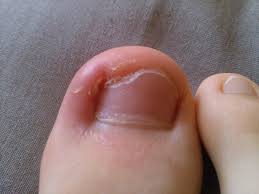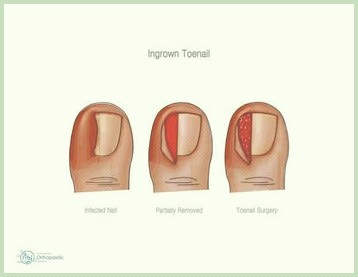Nail Ingrown
Definition
An ingrown nail is called a nail that “enters the flesh”. The ingrown nail concerns the young adult, and the big toe in most cases (95% of ingrown nails).
History of the Incarnate Nail
The first manifestation of the ingrown nail is the occurrence of a cutaneous bulge, reactive to the insertion of the nail into the flesh. This bulge can cover the ingrown nail, aggravating the pain.
Because it attacks the skin, bacteria normally present in the skin sometimes enter the body, and this causes infections. This ingrown nail surinfection is treated with regular disinfection by antiseptic solution such as Hexomedine, Dakin or Bétadine. Possibly an antibiotic ointment may be prescribed by your general practician.
Under no circumstances should these ingrown fingernail overloads be overlooked, since the infection can spread to the underlying bone. Especially in diabetic patients, we must be wary of the persistence of this ingrown nail.
This cutaneous break-in, out of septic context, can be taken care of initially by a podiatrist. Chemical destruction of the ingrown silver nitrate nail is a frequent source of recurrence.
Surgical treatment
If this is not enough, or lasts in time, surgery of this ingrown nail is possible. It takes place under local anesthesia. It consists of a removal of the part of the nail that enters the skin. It is combined with sterilization by abrasion or bed cleaning (live part of the nail, at the base). We perform so that the nail does not grow back to the place where it entered the flesh.
You will have a large bandage to prevent bleeding for 48 hours. You will need to raise your foot well initially. Care that consists of a simple disinfection will be performed every 2 days for 2 weeks. In addition, the first bandage is replaced by a smaller one that allows you to take a shower and wear sneakers.
There are other techniques concerning the ingrown nail, such as phenol application, CO2 Laser vaporization, or YAG Laser with more inconsistent results. Also there are different surgical techniques, the most important remaining the experience, and the competence of your surgeon, with his own technique.
Prevent recurrence
To prevent the risk of recurrence of ingrown nails, which occurs in 3 to 5% of cases, it is recommended to cut the nails regularly. This cut should be made with the softest possible cutting angle, so as not to irritate the skin. It is also recommended to avoid wearing shoes that are too tight.




